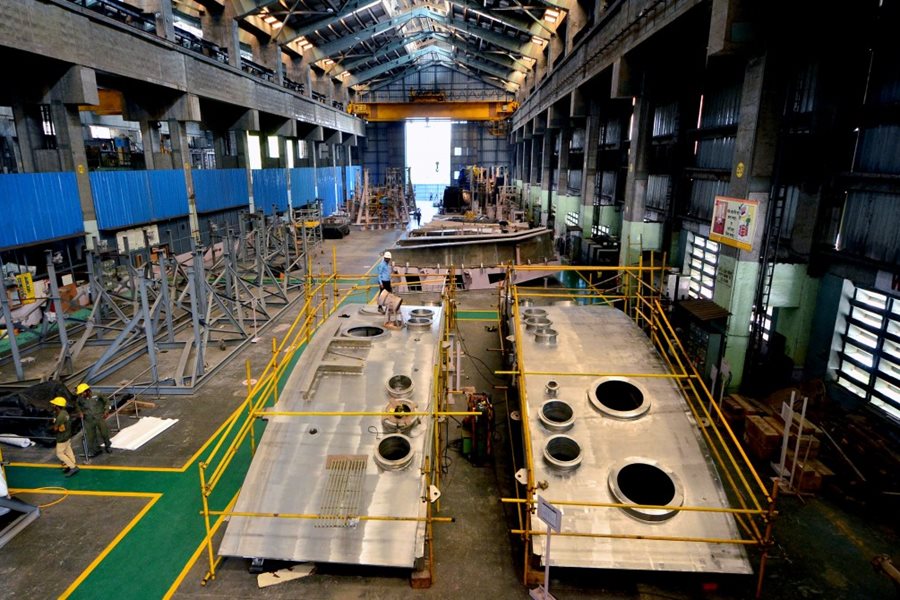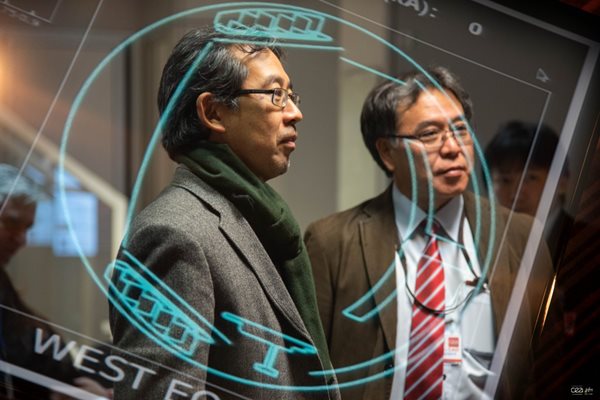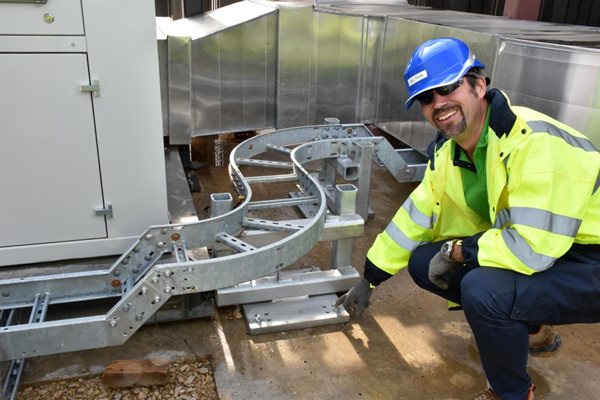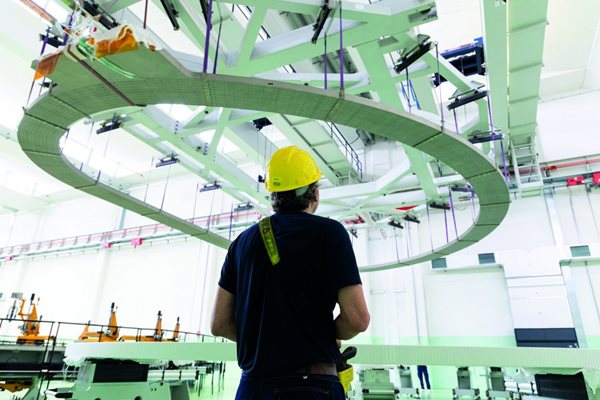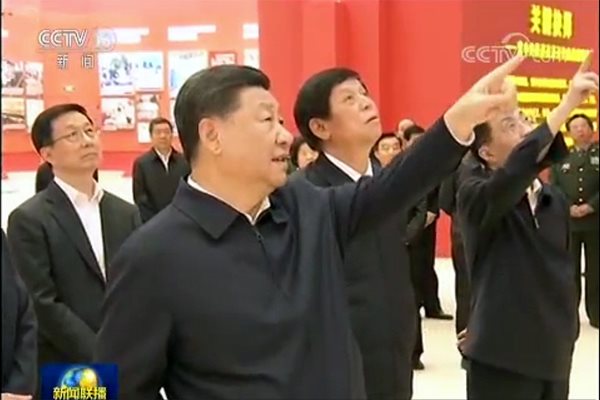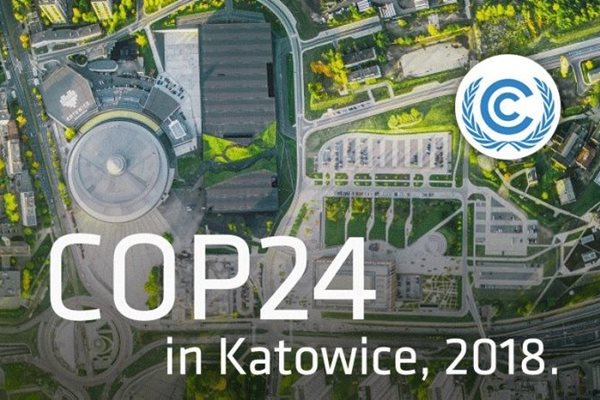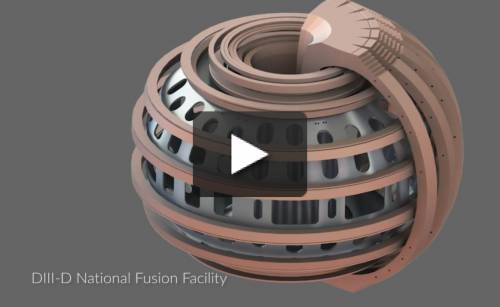
you're currently reading the news digest published from 26 Nov 2018 to 03 Dec 2018
featured4
of-interest2
video1
press5
featured
Manufacturing | In the cradle of the cryostat
On the northwestern coast of India, facing the Arabian Peninsula, Hazira is one of the subcontinent's major industrial hubs. Under the still-blazing autumn sun, the landscape is one of refineries, shipyards, power plants, storage tanks and endless queues of oil and container trucks. It is here, at the Larsen & Toubro Ltd manufacturing complex, that a critical ITER component is taking shape. Between ocean and mangrove, amidst a world of dust and rust, the Larsen & Toubro Ltd 'campus' is like an oasis of green and cool. In the mid-1980s, the mammoth Indian conglomerate drained close to one thousand acres of marshland to establish this multi-facility complex. Thirty years later, the place is a unique aggregation of manufacturing facilities that turn out offshore oil platforms at the rate of 10 to 12 per year and manufacture ships, submarines, tanks, giant boilers and turbines ... At one kilometre long, the west campus' special steels and forging facility is one of the largest in the world. In an atmosphere that mixes space-age technology with a 19th century steel mill atmosphere, 'manipulators' the size of freight train locomotives slowly move amidst giant furnaces and massive steel ingots laid to cool on sand beds. The facility produces more than 40,000 tonnes of finished forgings annually. Across the road on the east campus, administrative buildings, fabrication facilities, workshops and port installations cover close to one hundred hectares. This environment is the cradle of the ITER cryostat, the largest of the Tokamak's components—a giant, leak-tight cylinder 30 metres high and 30 metres in diameter that will act as a 'thermos' to insulate the ultra-cold magnets from the environment. From humble beginnings in the form of ingots that look strangely like truncated Doric columns, to the shining stainless steel segments ready to be shipped to the ITER site, it all happens here. Since late 2015, segments for the ITER cryostat's base section and lower cylinder have been successively forged, machined, finalized, shipped to the ITER construction site, and assembled and welded in the onsite Cryostat Workshop. In December 2013, as the first mockups were produced to demonstrate and validate welding and manufacturing sequences and techniques, Madhukar Kotwal, then president of Larsen & Toubro Heavy Engineering, told Newsline that despite the company's accumulated experience in manufacturing nuclear and space components, the ITER cryostat was so 'special' that it presented unprecedented challenges, both technical and organizational. Five years later, the challenges have been met and overcome and the manufacturing of the segments for the 'huge assembly' of the ITER cryostat is nearing its end. In the east campus, inside Medium Fabrication Shop #4, work is now underway on the last two orders that Larsen & Toubro is filling for the ITER cryostat: seven segments of the 430-tonne upper cylinder are packed and ready for dispatch; another two are undergoing finishing works and inspections; a segment prototype for the 655-tonne top lid is in the last stage of fabrication; and various tasks are being performed on the 'ribs,' 'flanges,' 'knuckles,' and 'crown' that make up a top lid segment (see further technical detail in the photo gallery below.) Although 7,000 kilometres and three and a half time zones stand between the Larsen & Toubro teams in Hazira and those on the ITER worksite, communication between them is constant. 'We have a conference call every single working day,' says Chirag Patel, the Larsen & Toubro project manager for the ITER cryostat and in-wall-shielding (see box). 'And we will soon be implementing Wi-Fi-connected viewing goggles that will enable us to have a better visual assessment of the ongoing works in the Cryostat Workshop at ITER.' In the summer of 2019, the 12 top lid segments will be shipped to ITER, marking the end of a formidable industrial venture that has spanned two continents and involved hundreds of specialists in both Hazira and at the ITER site in Saint-Paul-lez-Durance. Click here to watch the 'Made in India' video.
Fusion world | WEST tokamak controlled from Japan
On a large video wall in Rokkasho, Japan, a plasma generated in the south of France flashes briefly. Operators are testing remote data acquisition and control techniques—the same techniques that will one day make it possible to carry out experiments on ITER—by demonstrating them on existing devices such as the WEST tokamak. The Remote Experimentation Centre (REC) in Japan reproduces the control room of a fusion research facility, with functions for preparing and setting plasma shot parameters, viewing the status of control data, operation monitoring, and data exchanging. From this space, scientists in Japan will one day participate remotely in ITER experiments. Before ITER enters operation, the team in Japan is verifying the functions required for remote experimentation by running tests and demonstrations on operating tokamaks such as JET and WEST today, and a little later on JT-60SA*. On 28 November, the first test was carried on WEST, the Tungsten (W) Environment in Steady-State Tokamak located just a few hundred metres from the ITER campus at the French Institute for Magnetic Fusion Research (IRFM). On the operational program that day were experiments to expose tungsten-coated components to the high heat flux coming from the WEST plasma. Two IRFM engineers were in Rokkasho to aid their Japanese colleagues in familiarizing themselves with data visualization, plasma shot parameters and, more generally, the organization of the experiment. The choice of experiment was particularly relevant, as ITER Japan has provided three plasma-facing units to WEST. After the success of this first experience collaboration will be pursued, as operators of the Remote Experimentation Centre continue to test the key elements of remote data acquisition and control techniques, including the software in charge of performing remote experiments, networks, data storage, and fast data transfer. The development of the Remote Experimentation Centre is progressing under the umbrella of the Broader Approach, an agreement between the European Union and Japan that establishes advanced R&D projects in support of ITER and the next-phase device. The centre is one of three projects at the International Fusion Energy Research Centre (IFERC) in Rokkasho. *The JT-60SA tokamak, which will come on line in 2020, also falls under the umbrella of the Broader Approach agreement. Read more about assembly activities underway here. You can also read the news in French.
Cable management | 10,000 kilometres of arteries
Put end to end, the cables that will crisscross the ITER scientific installation like arteries could reach the Peruvian capital Lima from the south of France—a total of 10,000 kilometres. One of the biggest challenges in their installation is the issue of sequencing—putting them in their place at the right time. Not as impressive and visible as large components but equally essential to the operation of ITER are the cables that will wind their way across the facility, connecting components, providing power and transmitting data. After years of planning the organization, routing and integration of the cables, the first 250 km of cable have already been installed on site and the rhythm is accelerating. The figure of 10,000 kilometres for all cables is an 'educated guess,' according to David Beltran—ITER's 'cable guy' who leads a cross-departmental team in charge of cable management. 'This estimate is based on the power consumption of auxiliaries in nuclear power plants. At First Plasma, more than 5,000 kilometres of cables will have been installed across the ITER site, with the remainder being laid until full operation in 2035. Cables at ITER come in all sizes and types. More than a third are power cables; others are for instrumentation, diagnostics or data traffic. All cables are halogen-free to prevent the creation of harmful substances during an accidental fire, and have undergone qualification according to standard procedures and related international standards. About ten percent of all cables have fire resistant properties, meaning that they continue to be fully functioning in the event of a fire. Depending on their location, cables need to meet additional requirements. In areas exposed to nuclear radiation for instance, they need to be able to sustain different accidental conditions such as radiation, high temperature and pressures. Cables for use in the vacuum vessel are designed to be compatible with this challenging environment. The accumulation of such properties can make cable production challenging, says Beltran. 'Some cables have an additional anti-rodent protection—their smell drives rats away,' he says about cables that will cross underground tunnels to connect the different buildings on the ITER worksite. Coordination and sequencing of the individual work phases constitute the biggest challenge according to Beltran—planning not only the order in which buildings need to be wired (many of them in parallel), but also the sequence of installation for structural supports, components and cables inside the buildings. 'Accessibility is a big issue when planning cable installations. We need to be sure that cable trays and cables—once put in place—do not pose an obstacle for other installation activities,' he explains. Big deadlines are approaching for wiring activities. By the end of the year, several buildings including the Assembly Building and the Magnet Power Conversion buildings, must be fully equipped with cables and related electrical building services such as HVAC, power sockets, switches and lights. The commissioning of electrical systems will begin in January in the Assembly Building, so that all building services are in full operation when the first vacuum vessel sector arrives from Korea in the middle of next year. In the meantime, the telltale signs of cable installation—stacks of cable trays and cable drums outside of the Cryoplant Building—pinpoint the upcoming cable installation priorities on the ITER worksite.
Toroidal field coils | Europe completes all "double pancakes"
Each one of ITER's giant, D-shaped toroidal field coils is built from seven 'double pancakes'—layers of spiralled conductor that carry electrical current. Contractors to the European Domestic Agency have now realized 70 of these 16-metre-tall components, completing the scope required for the fabrication of ten toroidal field coils. From the completion of the first full-size prototype in 2013, through the series winding of 70 double pancakes, it has been a highly technical industrial journey. The winding of the double pancakes is considered the most challenging phase of magnet coil fabrication, consisting of bending conductor lengths along a D-shaped double spiral trajectory. As the conductor must fit precisely inside the radial plate groove, it is vital to control its trajectory in the double pancake and in the groove of the radial plate with extremely high accuracy. The trajectory of the conductor, in particular, must be controlled with an accuracy as high as 0.01 percent. The completion of the 70 double pancakes is an important milestone for the European Domestic Agency, Fusion for Energy, and its suppliers Iberdrola Ingeniería y Construcción (project management, quality assurance, and planning); ASG Superconductors SpA (design of process, plant and tooling, manufacturing); and Elytt Energy SL (design and manufacturing of turn insulation, pancake impregnation plant/tooling), and radial plate manufacturers CNIM and SIMIC. See the full report on the European Domestic Agency website.
of-interest
President Xi Jinping explains ITER and fusion
On the occasion of the 40th anniversary of China's Reform and Opening, President Xi Jinping visited the Exhibition of Achievements and explained ITER and fusion energy development in China to the other six members of the Political Bureau, the highest decision-making body in China.
ITER @ COP24
Starting this week, politicians, scientists, strategists and non-governmental organizations meet in Katowice, Poland, for the 24th United Nations Climate Change Conference, COP24. ITER will present its quest for a new and clean source of energy on Thursday, 6 December, as physicist Greg de Temmerman steps into the ring to share the latest updates on the project. Following his talk, starting at 11:00 a.m. in the Climate Action Hub amphitheatre, there will be a screening of the award-winning fusion documentary 'Let there be Light.' You can see the entire talk on the COP24 website. Click on the respective agenda item on the right-hand side - the video will start after about one minute.
